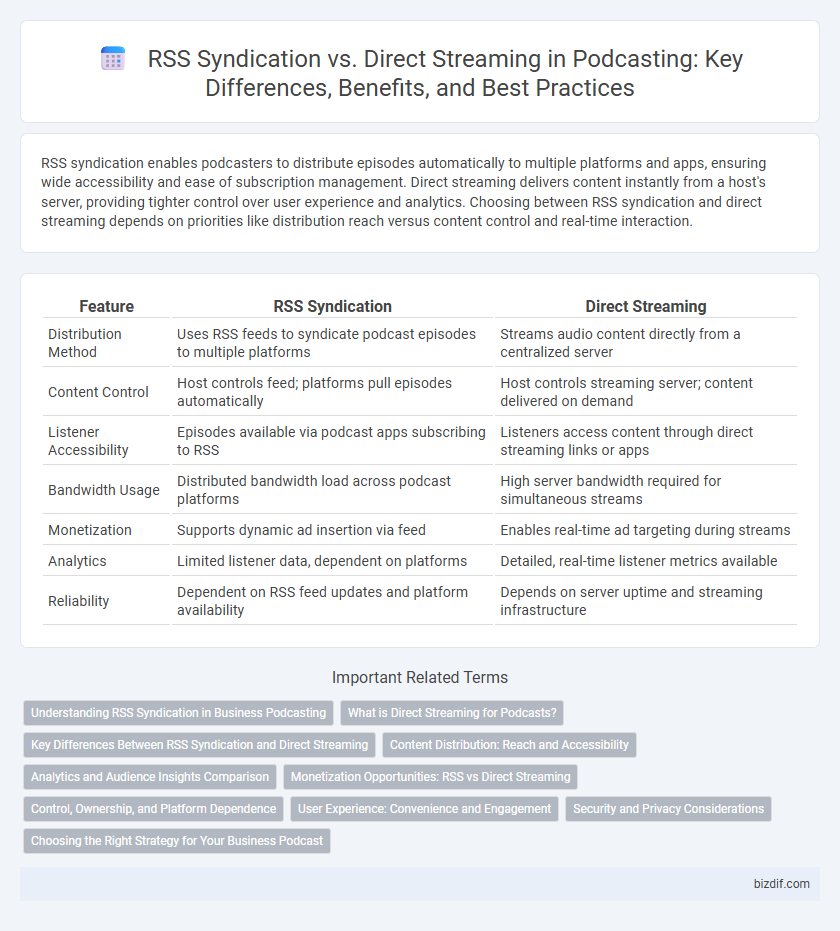RSS syndication enables podcasters to distribute episodes automatically to multiple platforms and apps, ensuring wide accessibility and ease of subscription management. Direct streaming delivers content instantly from a host's server, providing tighter control over user experience and analytics. Choosing between RSS syndication and direct streaming depends on priorities like distribution reach versus content control and real-time interaction.
Table of Comparison
| Feature | RSS Syndication | Direct Streaming |
|---|---|---|
| Distribution Method | Uses RSS feeds to syndicate podcast episodes to multiple platforms | Streams audio content directly from a centralized server |
| Content Control | Host controls feed; platforms pull episodes automatically | Host controls streaming server; content delivered on demand |
| Listener Accessibility | Episodes available via podcast apps subscribing to RSS | Listeners access content through direct streaming links or apps |
| Bandwidth Usage | Distributed bandwidth load across podcast platforms | High server bandwidth required for simultaneous streams |
| Monetization | Supports dynamic ad insertion via feed | Enables real-time ad targeting during streams |
| Analytics | Limited listener data, dependent on platforms | Detailed, real-time listener metrics available |
| Reliability | Dependent on RSS feed updates and platform availability | Depends on server uptime and streaming infrastructure |
Understanding RSS Syndication in Business Podcasting
RSS syndication plays a crucial role in business podcasting by enabling automated distribution of episodes across multiple platforms, ensuring broad audience reach without manual uploads. Unlike direct streaming, RSS syndication provides seamless content updates to podcast directories like Apple Podcasts and Spotify, enhancing discoverability and listener retention. Efficient RSS feeds also support metadata integration, boosting SEO and allowing precise analytics to track audience engagement and growth.
What is Direct Streaming for Podcasts?
Direct streaming for podcasts delivers audio content in real-time from a host's server to listeners without relying on RSS feed distribution, enabling instant playback without downloads. This method reduces delays associated with RSS syndication and improves control over content delivery, bandwidth usage, and listener analytics. Platforms using direct streaming enhance user experience by allowing immediate access and adaptive bitrate streaming for various devices.
Key Differences Between RSS Syndication and Direct Streaming
RSS syndication delivers podcast episodes through XML feeds that enable automatic updates and wide distribution across various podcast platforms, ensuring decentralized content availability. Direct streaming involves hosting audio files on a single server accessed directly by listeners, allowing for more control over content delivery and real-time analytics. Key differences include the method of content distribution, scalability, listener access flexibility, and the level of control over episode updates and analytics.
Content Distribution: Reach and Accessibility
RSS syndication enables podcasts to be automatically delivered to a wide range of apps and platforms, increasing reach by making content accessible across diverse devices and user preferences. Direct streaming provides instant playback without downloads but often limits distribution to specific platforms or websites, potentially reducing overall audience accessibility. Effective content distribution balances the broad compatibility of RSS syndication with the immediacy of direct streaming to maximize podcast reach and listener engagement.
Analytics and Audience Insights Comparison
RSS syndication offers detailed analytics through third-party platforms, providing data on downloads, listener demographics, and geographic distribution, enabling podcasters to track audience growth over time. Direct streaming gives real-time insights into listener behavior, such as session length and engagement metrics, allowing for immediate feedback on content performance. Combining both methods enhances understanding of audience preferences and optimizes content strategy through comprehensive data collection.
Monetization Opportunities: RSS vs Direct Streaming
RSS syndication offers broader monetization opportunities through dynamic ad insertion, sponsorship integrations, and affiliate links embedded directly in the feed, enabling podcasters to reach diverse platforms and audiences. Direct streaming limits monetization mostly to platform-specific ad models and paywalls, reducing control over revenue streams and audience data. Leveraging RSS feeds allows creators to maximize revenue by distributing content to multiple directories while maintaining flexible monetization strategies.
Control, Ownership, and Platform Dependence
RSS syndication offers podcasters full control and ownership of their content by enabling distribution across multiple platforms without reliance on any single service, ensuring broader reach and content permanence. Direct streaming centralizes content on specific platforms, which may simplify listener access but risks dependency on platform policies and potential content restrictions. Prioritizing RSS syndication supports long-term content autonomy and mitigates the vulnerability associated with platform dependence inherent in direct streaming models.
User Experience: Convenience and Engagement
RSS syndication enables users to automatically receive and organize podcast episodes through their preferred apps, offering seamless access and offline listening convenience. Direct streaming enhances engagement by allowing instant playback without downloads, catering to listeners seeking immediate content consumption. Balancing these distribution methods optimizes user experience by combining the reliability of syndicated access with the immediacy of direct streaming.
Security and Privacy Considerations
RSS syndication in podcasting provides a decentralized method, minimizing centralized data collection and reducing exposure to data breaches, thus enhancing privacy. Direct streaming platforms often require user authentication and backend data handling, which can pose risks related to data interception and unauthorized access. Choosing RSS feeds allows listeners to access content without revealing personal information, offering a more secure and privacy-conscious listening experience.
Choosing the Right Strategy for Your Business Podcast
RSS syndication offers widespread distribution by automatically delivering podcast episodes to multiple platforms, increasing discoverability and audience reach. Direct streaming provides greater control over user experience and analytics, allowing businesses to tailor content delivery and collect detailed listener data. Selecting the right strategy depends on business goals, with RSS ideal for maximizing exposure and direct streaming suited for brand-centric engagement and advanced tracking.
RSS Syndication vs Direct Streaming Infographic

 bizdif.com
bizdif.com